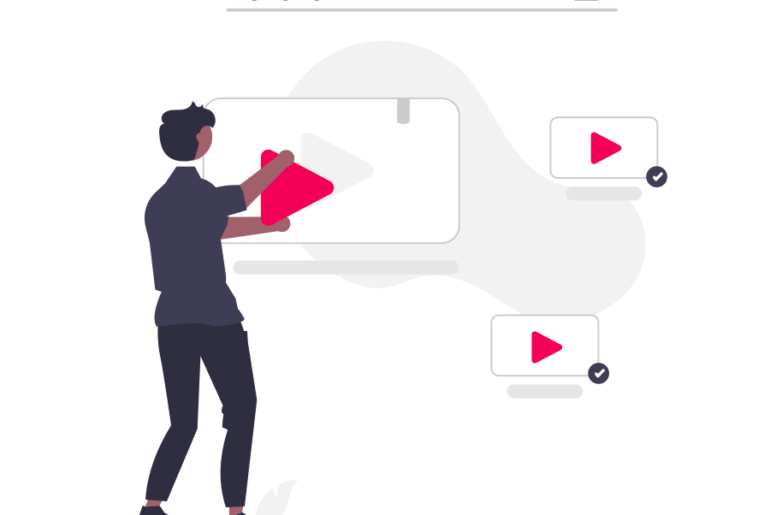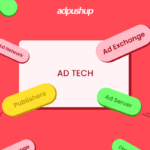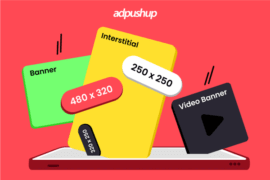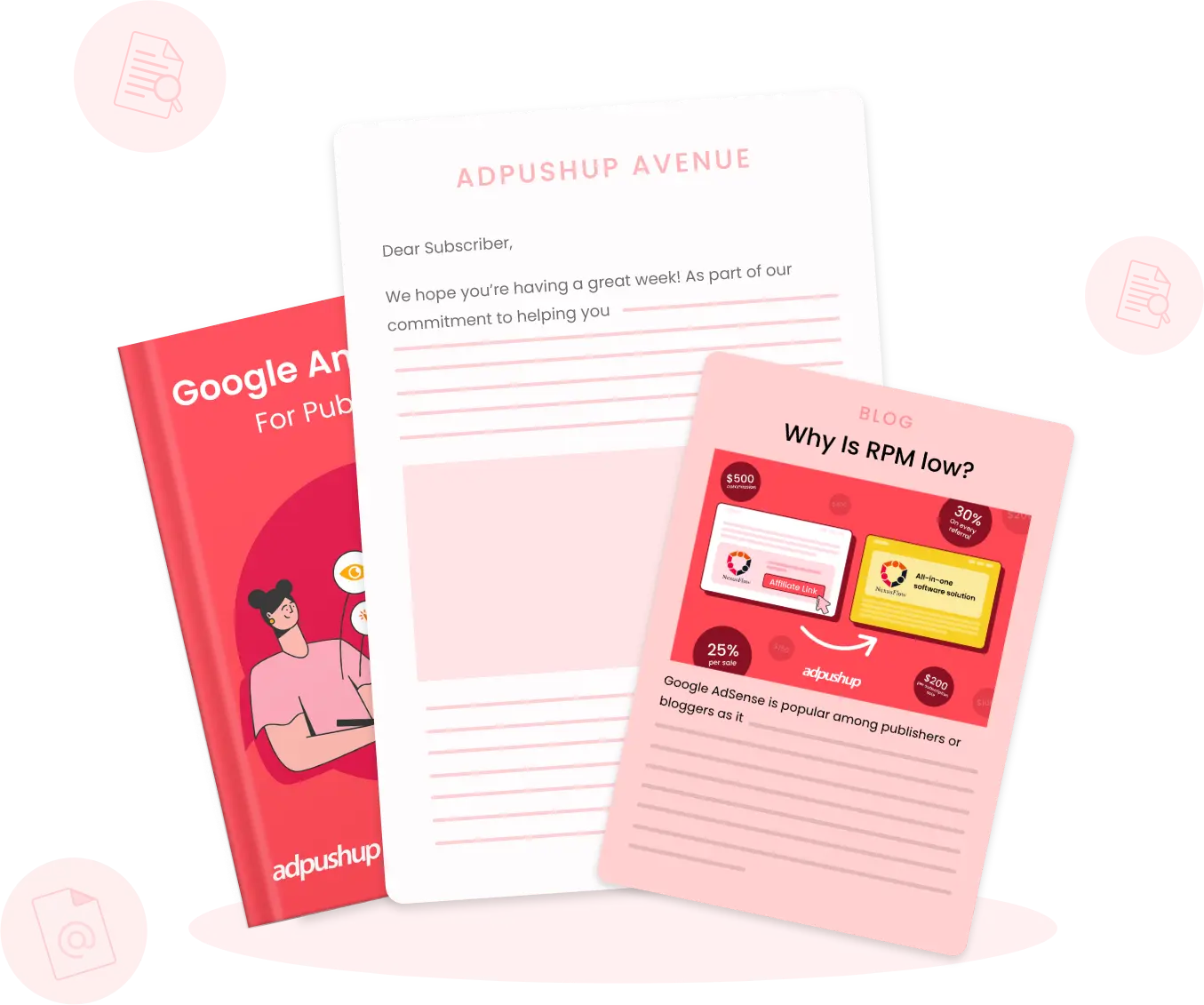Discover the power of rich media ads in our comprehensive guide for publishers. Learn what they are, how to implement them, and how they can elevate your advertising campaigns.
Publishers often write to us asking what are rich media ads?”So in our response, we simply say, “Rich media ads are about adding a twist of richness and creativity to boring, bland ads.” Let’s delve deeper into what exactly they entail.
Although not all ads are bad, we should filter out the obnoxious ones.
One of the primary objectives of many publishers is to drive better CPMs (and ultimately revenue). Thus, visitors should not be getting annoyed with too many ads that obstruct their journey on your site. God forbid. You wouldn’t want that.
This is why ad tech companies are always trying to create innovative ad formats.
The day-to-day advancement in ad technology is empowering publishers to be able to create impactful ads and leverage intelligent optimization.
Big or small, brands love rich media ads. This is because they’re interactive, effective, and deliver better engagement rates. So without getting into paralysis of analysis, let’s take a trip together to discover what rich media ads are and how you can make the most of them.
What Are Rich Media Ads?
Rich media ads, as the name suggests, are an amalgamation of text, images, audio, video, animations, and others.
These ads are dynamic in style and can mould as per the users’ on-screen / on-device movements. The intent is to make ads more interactive and deliver better user experience.
In layman’s language, you can think of these ads as a one-size-fits-all or one-ad-serves-all solution. Rich media ads are like visualizations brought to life.
Try imagining a banner having a static background and dynamic foreground behaving as per your on-screen movements. Sounds fascinating? We think so.
Also Read – What is Ad Format and What Users Prefer?
Why Integrate Rich Media Ads?
Now you must be wondering—why should I go for them? What can I possibly achieve out of them? Aren’t they too much of an effort?
Let us answer one by one.
Why Should You Go for Rich Media Ads?
If you’ve carefully read through all the rich media ad formats above, you might have noticed that these ads possess the characteristics of delivering high CTRs and CPMs. Moreover, the ads are highly engaging and provide better brand recall.
Real-life example: Avatar gains 35% higher engagement and audience attention span.
What can You Achieve out of Rich Media Ads?
With interactive ads like rich media ads, you may get help to attain a high interaction rate, better measurability, and scalability with in-depth metrics viz. number of users who viewed the video and percentage of video viewed, brand awareness/recall, and last but not the least, a memorable user experience.
Real-life example: Audi attains an 18% interaction rate and brand recall using rich media ads
Aren’t they too much of an effort?
Of course, they are. You might require a significant amount of time for it. Alternatively, if you have a team that works with you, they’ll probably need to broaden the horizon and create some brilliant rich media ads to answer the question of what are rich media ads. Because eventually, it’s worth the effort.
Real-life example: SyFy rich media ads get 2000 click-throughs in one day
Are you still thinking?
Rich Media Ads Examples
Here are some examples of what are rich media ads. They are categorized in terms of formats and modes of discussion.
- Interactive Banners
Banners that expand when clicked to reveal more content. These banners generally come with interactive games or quizzes.
- Video Ads
Video ads that play within a banner or expand to a larger size. These include in-stream video ads on platforms like YouTube, incorporating interactive elements.
- Interactive Images
Images with clickable hotspots that provide additional information or lead to a landing page. These can be panoramic images that users can explore by dragging or clicking.
- Carousel Ads
Ads that showcase multiple images or products in a carousel format. For example – carousel ads with interactive elements like swipeable galleries.
- Dynamic Ads
Ads that change content based on user interactions or preferences. These czn be personalized ads that display products based on the user’s browsing history.
- Augmented Reality (AR) Ads
Ads that allow users to virtually try out products using AR technology. AR ads that overlay digital content on the user’s real-world environment.
- Rich Media Pop-ups
Pop-up ads that include multimedia elements like videos or animations. Pop-ups with interactive forms or surveys.
- HTML5 Ads
Ads created using HTML5 technology for enhanced interactivity and responsiveness. Ads with animated elements, transitions, and dynamic content.
- Floating Ads
Ads that “float” on the webpage, remain visible as users scroll down. You might have come across those floating banners on websites with interactive elements or cals to action butons.
- Gamified Ads
Ads that incorporate games or challenges to engage users. These are incentivized gamified ads where users can earn rewards for participation.
- Social Media Ad Formats
Instagram and Facebook Carousel Ads. Snapchat and TikTok ads that leverage interactive features.
- Rich Media Email Ads
Email advertisements with embedded videos or interactive elements. Emails that use dynamic content based on user behaviour.
Rich Media Ads vs. Standard Ads
Now that we have talked about rich media ads, let’s see how they are different from other ad formats.
| Standard Ads | Rich Media Ads |
|---|---|
| These are plain vanilla text or image ads. | These ads are audio/video-driven and rich in overall appearance. |
| They’re not interactive, i.e., they are static. | They’re expendable and behave as per user interaction, i.e., they are dynamic. |
| An upgraded standard ad supports. GIF format at most. | These ads complement flashy games and behaviorally targeted videos. |
| This ad file size can be anything up to 200 KB. | The file size of creatives is usually greater than 200 KB. |
| They’re not compatible with technologies like Java or HTML. | These ads are compatible with Java, Javascript, and HTML5. |
| Clicks on the ads usually take users to the advertiser’s page. | Clicks on lead may lead to canvas size expansion, floating, or sound; not necessarily just the advertiser’s landing page. |
| Ad performance is measured only using the click-through rate (CTR) metric. | Ad performance can be measured with multiple metrics for tracking user engagement. |
Also Read: The Top Mobile Ad Sizes for Increased Viewability
Where and How to Create Rich Media Ads?
Now that we have understood what are rich media ads, let us try to understand how to create them. HTML5 technology gives publishers the platform to create these ads and tools out there allow users to add intriguing elements to them. Here’s some guidance on how to create rich media ads that look fun and playful along with which tools you can use to create them. Let’s first take a look at where to create rich media ads.
Where to Create Rich Media Ads?
Tools such as Google Web Designer, Bannersnack, Bannerflow, AdCanvas, and MadYourself allow you to develop some nice looking rich media ads. Most of these tools offer free usage to some extent.
And some might even help you with readymade templates. If you’re somebody with a knack for design, platforms like Adobe (Animate CC4, Flash Builder) can lend you a helping hand. Likewise, Gimbal is widely known as a tool for creating mobile-specific rich media ads.
How to Create Rich Media Ads?
- Choose an HTML5 ad creator to start creating rich media ads.
- Be ready with media specific for your rich media ads viz. images, frames, graphics, etc.
- Save files in formats like JPG, PNG, or SWF to keep the file size in control.
- Add the needful media to your ad creator; whether banner or mobile.
- Follow the platform’s user interface as it leads you to create the ads.
Image: MadYourself.io
Top 5 Practices for Rich Media Ads:
- For the messaging, follow the K.I.S.S. rule aka Keep It Simple, Stupid.
- If you’re scaling from traditional ads to rich media ads, maintaining brand alignment in your presentations can be streamlined with tools such as an AI presentation maker.
- Consult a designer or expert to keep the ads visually appealing (basically attractive enough to attract clicks).
- Keep an eye on file size. You wouldn’t want a big file to increase your page load time.
- Create different versions if demographics like region, geography, season, language, etc. matter to you. Saw an example where I couldn’t help but just say, wow.
Rich Media Ad Formats
Rich media ads are sheer beauty and creativity. Plus, they bring in money. Take a look at these popular rich media ad formats and decide which one catches your eye.
#1 Rich Media Banner Ads
Ruling at the top (header) of the webpage, banner ads are the most widely used canvas. Banner ads are most likely to be seen because of their above-the-fold factor.
As a rich media banner ad, advertisers get the option to convert a static image banner to an appealing motion poster. This is probably an advertisers-and-publishers-favorite format.
- Placement: Top front on web and mobile.
- Characteristics: Spacious, high viewability, less load time, high engagement, high click-through.
#2 Rich Media Interstitial Ads
This fullscreen master ad format is highly intriguing. Hence, owing to their screen-wide attribute, interstitials is hard to miss and are a possible ad format to combat banner blindness. They support video and HTML5-based ad units.
- Placement: Full-screen on the web and mobile.
- Characteristics: Spacious, high performing for mobile, high viewability and yield, $4 to $15 average CPM, better recall, high load time.
#3 Rich Media Expandable Ads
As the name suggests, the multi-directional ads expand automatically as and when user-based triggers happen—hover, click, or tap. Therefore, these ads are the most interesting format to watch till the end, leading to high CPMs and better viewability.
- Placement: Left (expanding to the right portion of the screen) or right (expanding to the left portion of the screen) on the web and mobile.
- Characteristics: Compelling, high CPM and viewability, low on demand because of newness, high load time due to media filled, high CTR, high engagement, better recall.
#4 Rich Media Pushdown Ads
These ads are not exactly expandable but somewhat similar. The ads are in preview by default and push the content down to expand themselves once user-based triggers happen. The good part about these ads is they don’t really hide the content like other overlay ad units.
- Placement: Top front on web and mobile
- Characteristics: High CPM, high engagement, better recall, medium demand due to newness, high load time due to media-filled, resembles leaderboard (728×90).
#5 Rich Media Slider Ads
Again, as the name suggests, slider ads move as and when the user interacts with the device screen. The slider feature moves along as the page scroll and settles once the page scrolling stops. These ads are usually hosted on. SWF, IMG, or third-party codes.
- Placement: Bottom right corner of web and mobile.
- Characteristics: high CTR, high engagement, less disruption, inventory saving.
These are the most established ones. However, the world is a big place. And there’s no limit to getting creatively inclined. Here is a directory of what are rich media ads and popular formats publishers can offer on their websites.
If you’re new, I suggest you start by learning about basic ad formats and see what your users might like.
Where Can Rich Media Ads Be Placed?
Rich media ads can be strategically placed across a diverse array of digital platforms to optimize visibility and user engagement. Here are the platforms where we can use them.
Websites
On websites, these ads can take the form of embedded content within articles or prominent banners on headers, sidebars, and footers, ensuring that they capture the attention of visitors as they navigate through the site.
Social Media Platforms
Social media platforms, including Facebook, Instagram, Twitter, and LinkedIn, offer versatile opportunities for rich media ads, such as in-feed ads seamlessly integrated into users’ content streams, It also includes carousel ads that showcase multiple images or products. Next, sponsored posts that blend with organic content also foster a more natural user experience.
These platforms leverage the interactive and visually compelling nature of rich media to enhance brand storytelling and audience interaction.
Mobile apps present a dynamic landscape for rich media ad placements, with the ability to seamlessly integrate ads into the app’s interface or display interstitial ads between various content sections. Video platforms like YouTube allow for in-stream video ads that play before, during, or after users’ selected videos, providing an immersive advertising experience.
Search engines facilitate rich media display ads on their results pages and extend reach through partner websites within their display networks. Email marketing campaigns can incorporate rich media elements within the body of emails or newsletters, creating a more engaging and interactive communication channel.
E-commerce platforms, gaming environments, podcasting platforms, and even virtual and augmented reality applications each offer unique opportunities for tailored rich media ad experiences, allowing advertisers to connect with their audience in creative and impactful ways across the digital landscape. The key to success lies in selecting placements that align with the target audience and seamlessly integrate into the user experience of each respective platform.
Top 7 Benefits of Rich Media Ads
Rich media ads come with a wide array of benefits for the publishers. Let’s delve into some key benefits of incorporating rich media ads that can truly make a difference:
1. Increased User Engagement
Rich media ads have the power to captivate users’ attention by leveraging interactive elements like videos, animations, and games. These engaging features entice users to spend more time interacting with the ads, leading to higher engagement rates compared to standard ads. The result? Better brand awareness and improved conversion rates.
2. Enhanced Branding Opportunities
Next, using rich media ads, publishers gain a platform to showcase their brand’s creativity and uniqueness. The dynamic and visually appealing nature of these ads enables publishers to deliver their brand message in a more memorable and impactful way. This eventually fosters brand recognition and recall among the audience.
3. Improved Ad Performance Metrics
Rich media ads often yield higher click-through rates (CTR) and conversion rates compared to standard ads. The interactive elements and immersive experiences offered by rich media ads entice users to click on the ads and take desired actions. By delivering better ad performance metrics, publishers can attract advertisers and potentially command higher ad prices.
4. Higher Ad Revenue Potential
It’s no secret that rich media ads typically command higher ad prices due to their ability to deliver engaging experiences and generate superior results.
With increased user engagement and improved ad performance metrics, publishers can attract premium advertisers who are willing to pay more for ad placements. This, in turn, can lead to higher ad revenue and increased profitability.
5. Flexibility in Ad Formats and Creativity
Rich media ads also provide publishers with a wide range of formats and creative options to choose from. They can leverage interactive HTML5 ads, expandable ads, video ads, and other innovative formats to tailor their ad campaigns to the specific needs of their target audience.
The flexibility in ad formats allows publishers to experiment with different creative strategies and optimize their campaigns for better results.
Also Read – Ad Layout Optimization and Ad Layout Personalization
6. Better Audience Targeting and Data Insights
These ads often come equipped with ad targeting capabilities, enabling publishers to reach their desired audience more precisely.
By leveraging data-driven insights, publishers can target specific demographics, interests, and behaviors, ensuring that their rich media ads are delivered to the most relevant audience. This targeted approach increases the likelihood of ad engagement and conversions.
7. Improved User Experience
Unlike some standard ad formats that can be disruptive and intrusive, rich media ads are designed to blend seamlessly with the content and provide a non-intrusive user experience. Their goal is to deliver value to users by offering interactive and informative experiences.
As a result, users perceive the publisher’s website or app more favorably, contributing to an overall positive user experience.
Rich media ads, while visually appealing and engaging, come with a set of drawbacks. Let’s have a look.
What are Some Cons of Rich Media Ads?
One major concern is their impact on website loading times. The inclusion of multimedia elements such as high-resolution images and videos can slow down page loading, resulting in a potentially frustrating user experience. This can be particularly problematic for users on slower internet connections or those accessing content on mobile devices. Additionally, the complex nature of rich media ads may lead to compatibility issues across different devices and browsers, causing inconsistencies in how the ads are displayed.
So in summary Rich Media Ads face the following cons:
Page Loading Concerns
Rich media ads can significantly impact website loading times. The inclusion of high-resolution images and videos may result in slower page loading. Users on slower internet connections or mobile devices may experience frustration.
Compatibility Issues
The complexity of rich media ads may lead to compatibility issues. Inconsistencies in how ads are displayed across different devices and browsers can be problematic.
User Distraction
The captivating nature of rich media ads may divert users’ attention from the main content. Disruption of the user journey can contribute to a negative perception of the ad and website experience.
Bandwidth Consumption
Rich media ads often require more bandwidth. Increased data consumption may lead to dissatisfaction, particularly for users with limited data plans.
Performance Measurement Metrics For Publishers
Rich media ads are interactive. That’s a good sign! And moreover, they come with specific metrics meant for publishers to measure the performance of their rich media ad efforts. Here they are:
- Interaction rate: The percentage value of users/audience engaging with the ad.
- Interaction time: The average amount of time users spend engaging with the ad.
- Display time: The average time for which the ad is displayed on the web page.
- Dwell rate: The percentage of users seeing specific ads and engaging with those ads through movements like hover, but not ad clicks.
- Expansion rate: The ratio of ad expansions to the total number of ad impressions (applicable on expandable ad formats).
- Average view time: The average length of play with the total length of play of video ads.
- Views and completions: The start and finish rate for video ads (helpful in determining user interest).
- Pauses, rewinds, mutes, and closes: The tracking of user-based events like video pause, rewind, mute, or close (provided by some rich media tracking systems).
- Custom events: The tracking of events like mouse hover, downloads, or others.
How to Place Rich Media Ads?
To effectively place rich media ads, start by understanding your target audience’s behaviour and preferences.
Diversifying your placements through ad networks, both general and industry-specific, can help automate and expand your ad reach, reaching a broader audience and increasing the chances of engagement.
Optimize your rich media content for each chosen platform. Tailor your messaging and creative elements to suit the unique characteristics of social media, video, display ads, or other channels. Ensure that your content seamlessly integrates with the user experience on each platform. Consistency in messaging and visual identity across various placements helps reinforce your brand and message in the context of rich media advertising.
Finally, regularly monitor and analyze the performance of your rich media ads. Use analytics tools to track key metrics such as engagement, click-through rates, and conversion rates specific to rich media advertising. Based on these insights, be ready to adjust your strategy, refine your targeting, and optimize your content to achieve better results over time. Regular evaluation and adaptation are crucial for a successful and impactful rich media advertising campaign.
Implementing Rich Media Ads on Websites and Apps
Implementing rich media ads on websites and apps involves incorporating interactive and engaging elements into ad units to capture users’ attention and enhance their advertising experience.
These ads go beyond static images or text and can include features such as videos, animations, games, surveys, and more.
Here are the steps involved in implementing rich media ads:
Develop Ad Code
Th ad code will be implemented on your website or app to display the rich media ad. Ad platforms usually provide code snippets or tag management solutions to simplify the implementation process.
Integrate Ad Code
If you’re working with a website, place the ad code in the desired locations, such as specific web page sections or within article content. For apps, integrate the code using the relevant ad SDKs (Software Development Kits) provided by the ad platform or ad network.
Test and preview
Before launching your rich media ads, thoroughly test them across different devices, browsers, and operating systems to ensure they function correctly and provide a seamless experience. Previewing the ads allows you to make any necessary adjustments before deployment.
Monitor and optimize
Once the rich media ads are live, monitor their performance regularly. Track key metrics such as impressions, clicks, conversions, and engagement rates. Use this data to optimize your ads by adjusting targeting parameters, creative elements, or placement strategies to maximize their effectiveness.
A/B testing
Consider conducting A/B tests by creating variations of your ads to determine which combinations of creative elements, calls-to-action, or targeting strategies yield the best results. This iterative approach helps refine your ad campaigns and improve their performance over time.
Implementing these ads requires careful planning, creativity, technical expertise, and ongoing optimization. By leveraging the interactive capabilities of rich media, you can create engaging experiences for your audience and achieve better advertising outcomes.
Conclusion
New-age publishers are focusing on user experience as much as they care about revenue. This is when rich media ads come into play.
Standard ads sell with imagery and graphical representation. Text ads sell with the power of words. Similarly, rich media ads elicit direct user interaction in different ways.
Events like ad float, ad expansion, ad sliding, and the rest prompt more user interaction without necessarily overlapping the page content (for which the visitors actually came).
Moreover, as the world is drifting towards video form of content, rich media ads are providing in-depth metrics to measure the even most granular data to see performance.
Nearly a decade ago when display ads just entered, the average CTR used to be anywhere above or around 5-7%. Over the years, the number has dropped and reached a mere 1% being the standard click-through (or less).
Given that, publishers aiming to achieve better click-through and serious brand awareness are shifting to rich media ads. It is because current data indicates that by the end of this decade, static ads might not be seen at all.
Frequently Asked Questions: Rich Media Ads
You should use rich media ads for better revenue. If you’ve carefully read through all the rich media ad formats above, you might have noticed that these ads possess the characteristics of delivering high CTRs and CPMs. Moreover, the ads are highly engaging and provide better brand recall.
With interactive ads like rich media ads, you may get help to attain a high interaction rate, better measurability, and scalability with in-depth metrics viz. number of users who viewed the video and percentage of video viewed, brand awareness/recall, and last but not the least, a memorable user experience.

Deepak has a keen eye for detail and a deep understanding of the ad tech landscape. Whether it’s through in-depth articles, thought-provoking insights, or compelling storytelling, he’s dedicated to helping people navigate the complex world of ad tech with the simplicity of his words.








2 Comments
Pingback: Promotion Strategy: The Ultimate Guide for Your Business in 2019
Pingback: 15 Reasons Why Publishers Should Consider Rich Media Mobile Ads – Airtory Blog